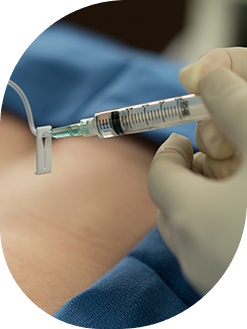Overview
A Cervical Epidural Steroid Injection combines a corticosteroid and anesthetic to provide both immediate and long-term pain relief. The corticosteroid works to reduce inflammation and swelling in the epidural space, relieving pressure on irritated nerves and surrounding soft tissues. This reduction in inflammation helps alleviate pain over time. Meanwhile, the anesthetic delivers immediate relief, allowing patients to experience comfort shortly after the procedure.
Is it right for me?
A Cervical Epidural Steroid Injection may be an effective treatment option if you’re experiencing neck, head, or arm pain caused by conditions such as:
- Cervical degenerative disc disease
- Post Laminectomy Syndrome
- Cervical spondylosis
- Cervical radiculopathy
- Cervical spinal stenosis
What is the procedure like?
During a Cervical Epidural Steroid Injection, a thin needle is carefully inserted into the epidural space of the cervical spine under the precise guidance of X-ray imaging (fluoroscopy). Once the needle is correctly positioned, a combination of corticosteroid and anesthetic medication is injected. The corticosteroid works to reduce inflammation and swelling in the epidural space, relieving pressure on irritated nerves and soft tissues. This process provides long-term pain relief by addressing the root cause of the discomfort. Meanwhile, the anesthetic medication offers immediate pain relief, helping patients feel more comfortable shortly after the procedure.
What happens after the procedure?
The anesthetic medication in a Cervical Epidural Steroid Injection provides immediate pain relief. For some patients, this single injection may be sufficient to alleviate their symptoms. For others, the injection is most effective when used in combination with physical rehabilitation or other treatments as part of a comprehensive pain management plan. Pain relief from an epidural steroid injection can last anywhere from one week to one year, depending on the individual and the severity of the condition. Follow-up care and additional injections may be recommended if symptoms persist.


